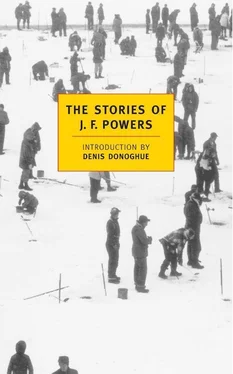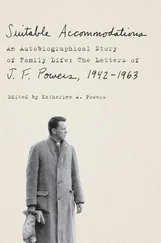On the good days in October and November, the Bishop spent many happy hours at “the job,” as it was called. Had bishops in the Middle Ages been so occupied, they might have saved a few years on cathedrals centuries in the building, he thought, for it seemed to him that the men accomplished more when he was around. Some of them he knew from other jobs, and called by name, and others he got to know. One day, he took aside a young workman who was to be married the following morning and spoke to him on the purpose of sex in God’s plan, and was so pleased by the response that he gave the young man the rest of the day off and also a cigar, which, since it was a good one, he advised him to save for his honeymoon. Others he spoke to on the purpose of work — a curse, yes, but also a means of sanctification — and cited the splendid example of St Joseph, a carpenter, the patron of workmen, or working-men. (The Bishop preferred those words to “worker.”) To give additional substance to his remarks, the Bishop spoke of the manual labor he had performed in the years when, home from the seminary for the summer, he’d driven an ice wagon and worked on a threshing crew, and also, though briefly, as a section hand on the Great Northern. “Between Barnesville and Moorhead — until I was overcome by the heat.”
By December, the foundation had been poured, the structural steel was in place, and the walls were rising — so slowly, though, that it didn’t pay the Bishop to visit the job daily. The men he knew were gone. A few masons drew $4.05 an hour. The Bishop was reluctant to interrupt them. Inside, the air smelled and tasted of oil. Outside, the ground was frozen. By the end of December, the architects — Frank and Frank, of Minneapolis — and the contractors — Beck Brothers, of Ostergothenburg — were feuding.
The Beck brothers (there were four of them) said that Frank and Frank, also brothers, were making too many changes in the plans. If Beck Brothers had known this was going to happen, they wouldn’t have bid on the job, they said. They hadn’t really wanted it. The plans called for a church such as Beck Brothers had never built before, or seen. “Too goddam modern,” they said.
None of this reached the Bishop directly, and almost all of it he discounted, having dealt with contractors for many years, but one evening at the Webb, early in February, he mentioned the part that did bother him.
“Frank and Frank are modern, all right, but they’re not too modern,” Monsignor Gau explained. “Contemporary” was the word for them. They believed in beautiful but simple structures, less expensive, but more impressive structures, and churches were their specialty. They’d done churches in such places as Milwaukee, Dallas, and Fargo, not to mention St Paul and Minneapolis. “They’re tops — and so, locally, are Beck Brothers,” said Monsignor Gau.
“Yes, I know,” said the Bishop.
“I can tell you what the trouble is, but you can’t do anything about it.”
“No?”
“Frank and Frank are from Minneapolis, if you know what I mean.”
The Bishop did. More than once, he’d heard the contractors refer to the architects as dudes.
The feuding continued into April. In April, the Bishop was planning to fly to Rome.
By then, the cathedral was beginning to look like something — a chasuble, said the architects; a coffin, said the contractors. It looked like neither, the Bishop thought, and it never would unless you viewed it from above, from an airplane. The Bishop thought that the little model of the cathedral in the contractors’ shack could be blamed for much of the trouble — it did look like a chasuble or a coffin — and so, on his last visit to the job, before leaving for Rome, he carried it off and locked it in the trunk of the car.
That evening, in the main dining room of the Webb, which he wouldn’t see again for perhaps a month, the Bishop got a pleasant surprise, for there, not too close to the organ, having a drink, and soon to break bread together, it seemed, were the two architects and the four contractors. Monsignor Gau was also there, but the Bishop had expected him.
“Well, well,” said the Bishop, joining the party. He sat at one end of the table, Monsignor Gau at the other. On the Bishop’s right sat an architect, on his left a contractor, and on Monsignor Gau’s right and left there was one of each. The seating arrangements had been worked out by Monsignor Gau, the Bishop felt, but how had Frank and Frank and Beck Brothers been brought together?
Presently, this question was answered for the Bishop — and for the Beck brothers, too, to judge by their faces. An architectural journal of excellent repute and wide circulation was planning an article on the new cathedral. If it followed the usual pattern of such articles, said one of the Franks, there would be photographs of the new cathedral and of those intimately associated with the job. “All of us here.”
“Why me?” said Monsignor Gau, with a surprised look that didn’t fool the Bishop, for obviously Monsignor Gau had heard the good news earlier, had talked it over with Frank and Frank, and on the strength of it had arranged the evening.
“You’re rector of the Cathedral — that’s why,” said the Bishop. “But why me?”
“It’s your church,” said Monsignor Gau. This was true. In fact, without the Bishop it wouldn’t be a cathedral.
The evening now went better. The Beck brothers, who were rather shy men away from their work, opened up as they hadn’t before. Frank and Frank said that the food at the Webb surpassed anything Minneapolis could offer and, a little later on, that they wished there were contractors like Beck Brothers in Minneapolis. At that point, the Bishop called for a round of Danish beer, a new thing at the Webb, and they drank a toast to the job.
The Bishop, trying to hold the attention of those at his end of the table, said that they might be interested to know that he had at one time given some thought to building the cathedral out of fieldstone. Yes, plain, ordinary, everyday stones, just as they came from the hand of God and were collected by farmers from their fields. The true and special character of the diocese and its people might be expressed in a cathedral of fieldstones. Monsignor Gau, however, had more or less discouraged the idea, saying that he doubted if fieldstones would look good in a structure of such size, or if fieldstones would hold together as well as, say, bricks. The Bishop had had nothing against bricks, but for a cathedral he preferred stone — good, honest stone. Yes, he was happy with the gray stone that had been chosen. He had wanted a rough finish, yes, until he had learned that this would be too hard to clean, and now he was happy with the smooth. For some reason, perhaps because of his romantic ideas about cathedral-building, he was sorry that the walls wouldn’t be solid stone — that the stone slabs, which were being anchored to the steel structure, were only two inches thick. Yes, he’d have reason to be sorry if the walls of the cathedral were solid stone — no air space, no insulation. He knew how buildings were constructed now, and wouldn’t have it any other way. He wasn’t complaining. Yes, he knew that they were doing things with stone that had never been done before, using it as if it were plywood, saving time, labor, and stone, and he was happy. He wasn’t complaining. Why should he? He was getting everything he’d ever wanted in a cathedral. It would be ideal for processions — wide aisles, assembly space, space to maneuver in. He was getting landscaped parking lots. He wasn’t getting as high a structure as he’d wanted at first, but, as Monsignor Gau had pointed out to him, the site would do a lot for the cathedral. From across the river, from the new highway, it wouldn’t look anything like Mont-Saint-Michel — another idea the Bishop had had in the very beginning and recognized as crazy even then. In short, he was getting a fine contemporary building with a distinct Romanesque flavor. He was getting real arches. “Oh, I’ve entirely given up the idea of fieldstones. I wouldn’t want ’em now if I could have ’em. But from what I know now, I think it might have been possible.”
Читать дальше












